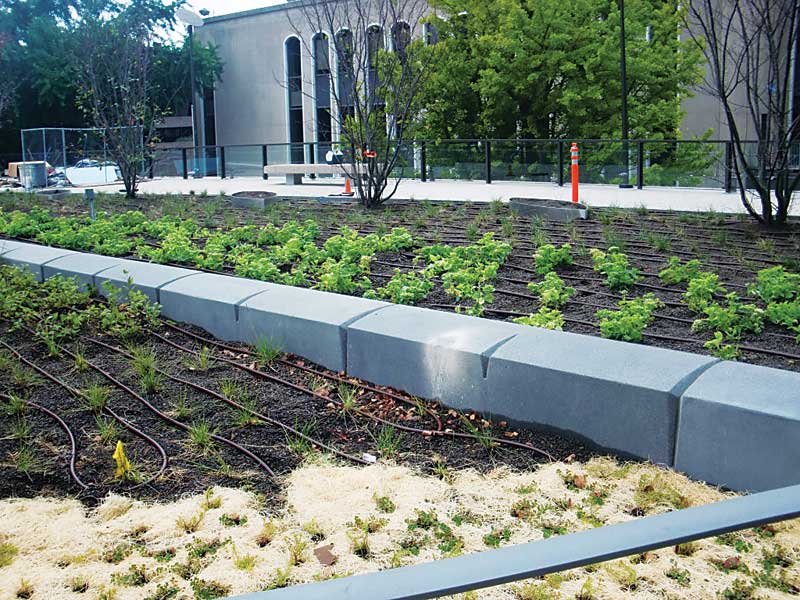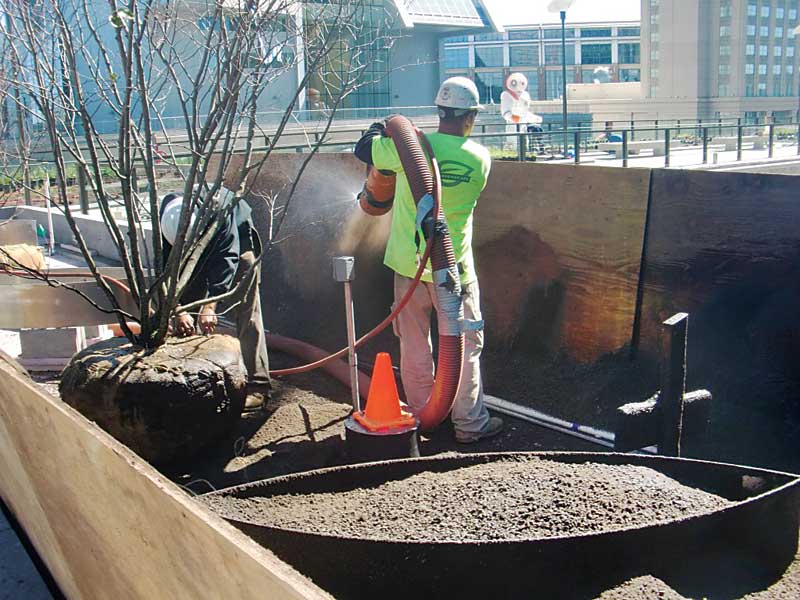

Roof gardens and terraces
Rooftop oases where people amble along a plaza stocked with foliage and furniture—such as the widely publicized Terminal 5 Rooftop at John F. Kennedy International Airport—are examples of ‘intensive’ green roof. They are often labor-intensive, both in terms of initial installation and ongoing irrigation and maintenance.
Intensive green roofs can act as an extension of the building, adding attractive usable space where there might otherwise be a blank stretch of featureless roof membrane. As an amenity, intensive green roofs can capitalize on unused portions of an existing building; they have the added benefit of drawing positive attention to building envelope retrofits by showcasing the building owner’s commitment to environmentalism, sustainability, and well-being of tenants and building users.
To accommodate trees and other large plantings, growing media for intensive roof gardens tends to be deep (i.e. 300 mm [12 in.] or more, depending on the desired vegetation), with soil dense in organic material and fully saturated weights of 3.8 to 5.75 kPa (80 to 120 psf). This does not include the added weight of pavers, fixtures, furnishings, and decorative elements, along with the live load of visitors and maintenance personnel and equipment. (This means significant structural considerations for an existing building—for more, see “Vegetated Roofs: A Green Light for Your Building?”)
Extensive landscaped roofs
A lighter-weight, lower-maintenance option is an extensive green roof. Although it does not provide added usable space, an extensive assembly offers a lower structural load, minimal upkeep, and a greatly reduced cost over intensive systems.
To keep loading to a minimum, extensive systems use shallow growing media with high inorganic content that tends to have a much lower saturated weight (roughly 0.7 to 2.4 kPa [15 to 50 psf]) than that of an intensive green roof. Sedum, native grasses, and other hardy plants that are drought- and heat-tolerant allow extensive green roofs to flourish without supplementary irrigation. Although the weight of an extensive vegetated assembly is still more than a traditional built-up (BUR) or single-ply roof, these shallow, self-sustaining systems are often readily manageable as a retrofit option for existing buildings, as they tend to require little, if any, structural modifications.
Even pitched roofs can be fitted with extensive vegetated assemblies—some prefabricated tray systems are designed to accommodate slopes of up to 30 degrees, and even steeper grades can be managed using grids or lathes to secure the trays in place. However, if waiting for a roof garden to germinate and grow is not feasible, if maintaining plantings on a 48th-floor setback is impractical, or if the structure cannot tolerate additional load, then it is worthwhile considering systems more like a traditional low-slope roof, but with energy-saving perks.





What a nice overview of these issues. Vegetative/green roofs are a great amenity for inhabitants and building owners and EPDM membrane is commonly used as the roof cover. A small correction … prior to the 2010 edition of ASHRAE 90.1, there was no requirement for roof reflectivity. That provision was added for the 2010 edition in Climate Zones 1-3. Your statement of “…in previous editions, reflective roof assemblies were the standard, irrespective of geographic region” is incorrect.
Green roofs have become incredibly popular and are being designed and installed at an incredibly rapid pace. As an addition to the “Waterproof design” in this article, I would strongly recommend installing a conductive mesh beneath the waterproof membrane. This will now, always allow for an Electronic Leak Detection to be performed after completion of such elaborate vegetated roofs and/or any other amenity space idea. My company specializes in both high and low voltage testing (leak/integrity), Gaussen’s “Real Time Leak Detection and Alert Systems” (24/7 live monitoring) as well as installing the conductive mesh.
The recommendation to perform a leak detection prior to installing the green roof components is spot on and will only save time, money and frustration. You can find our specification for Electronic Leak Detection at http://atlanticleak.com/eld-specification/.
Great article!!